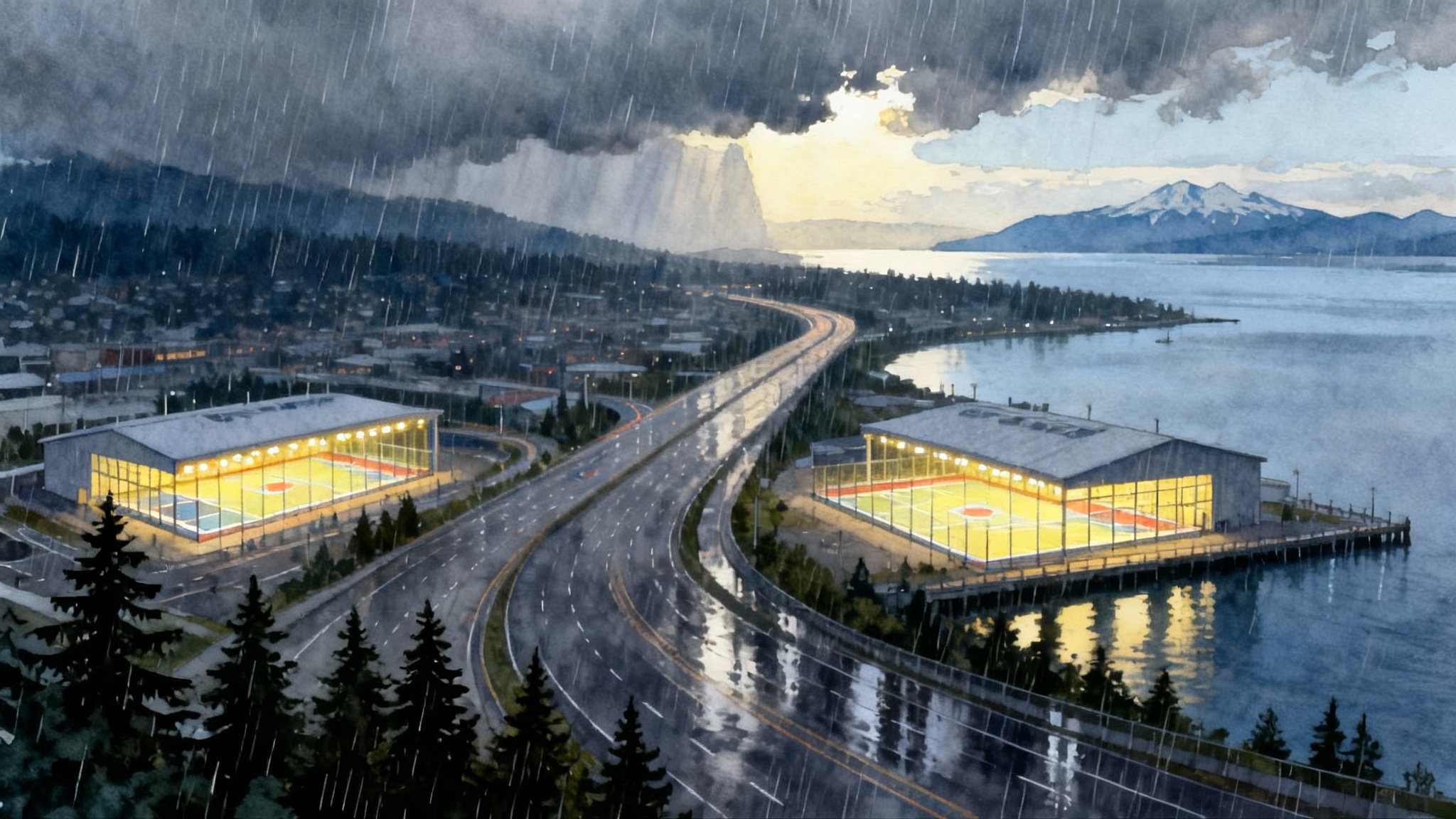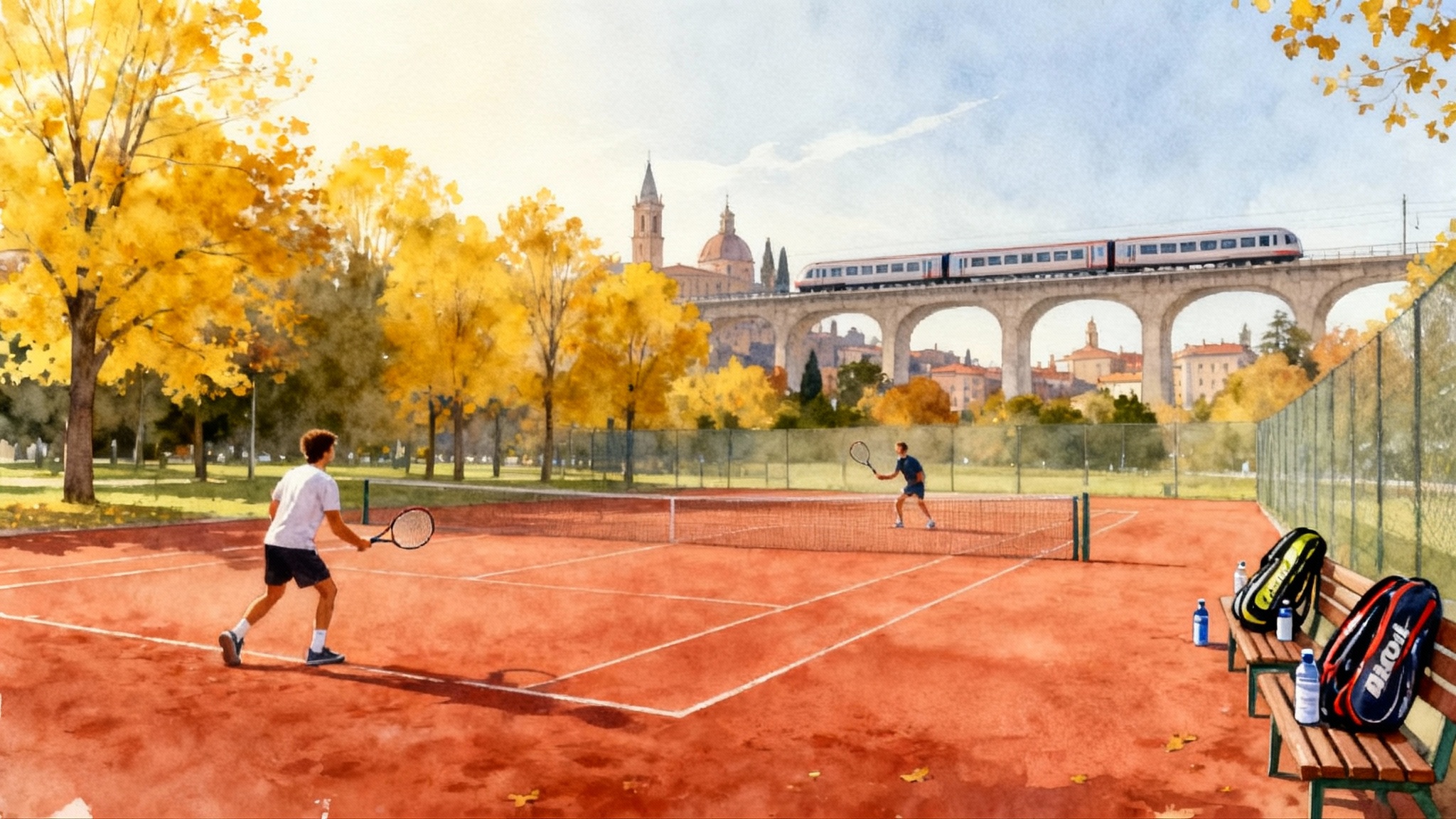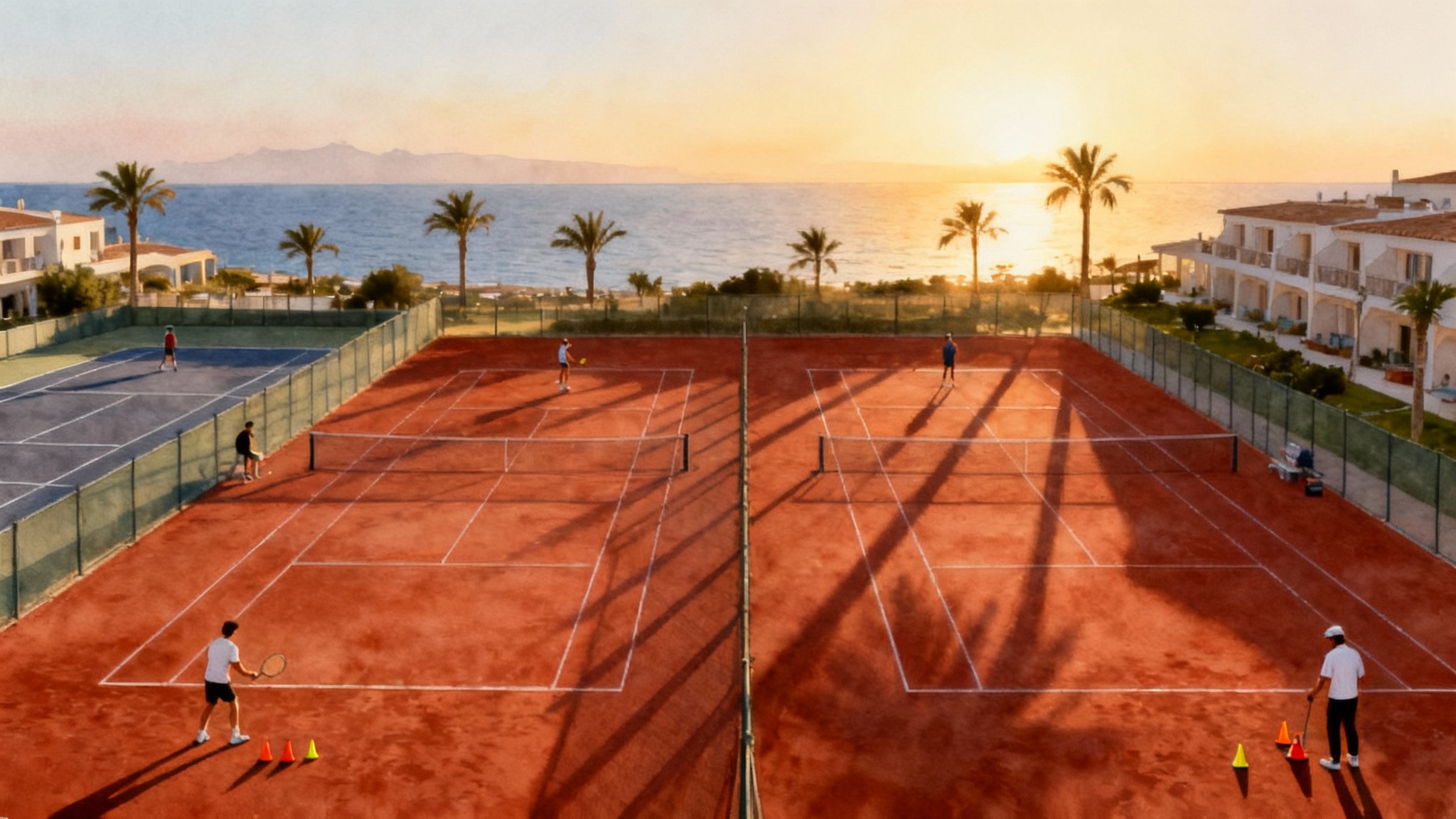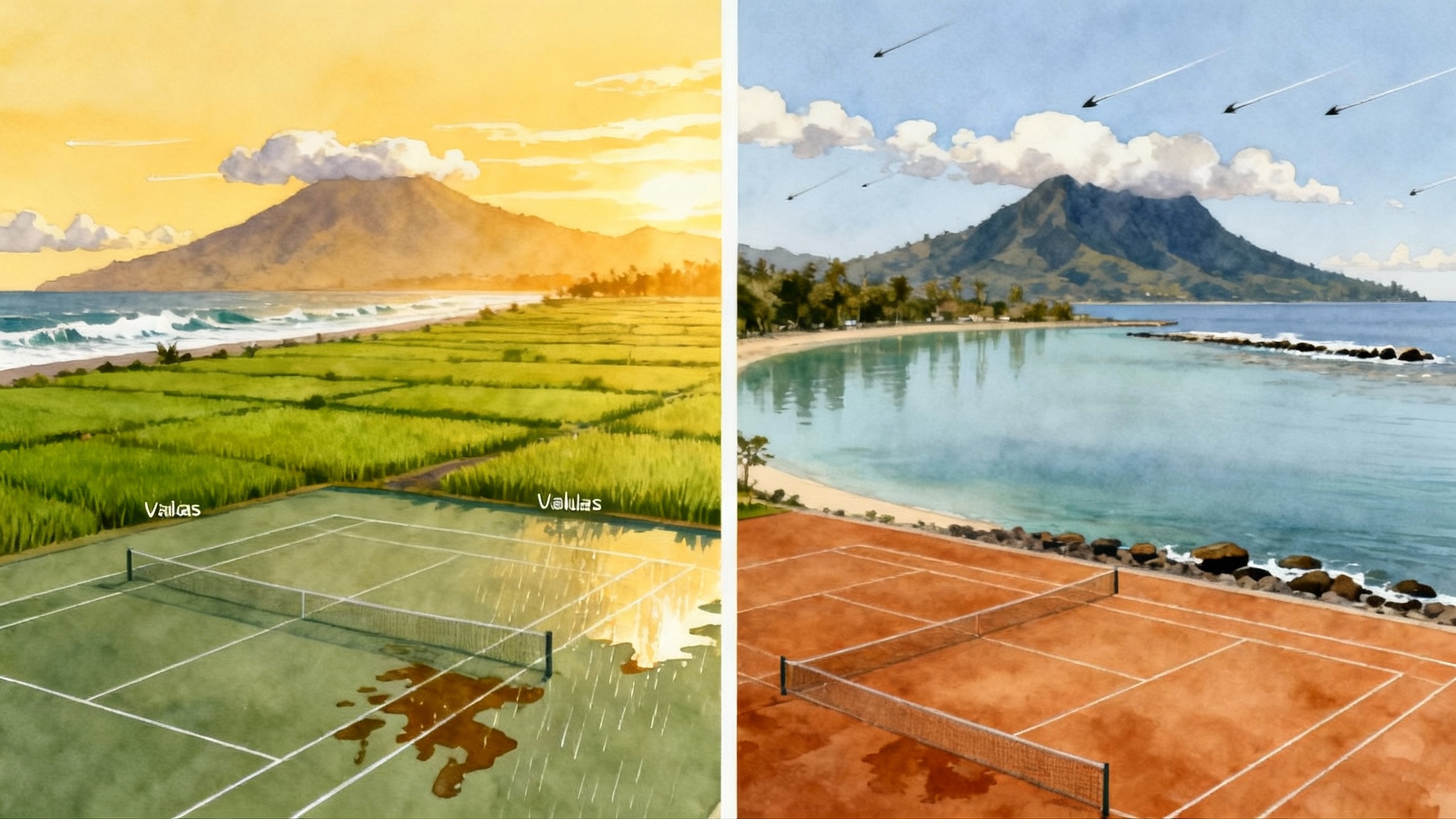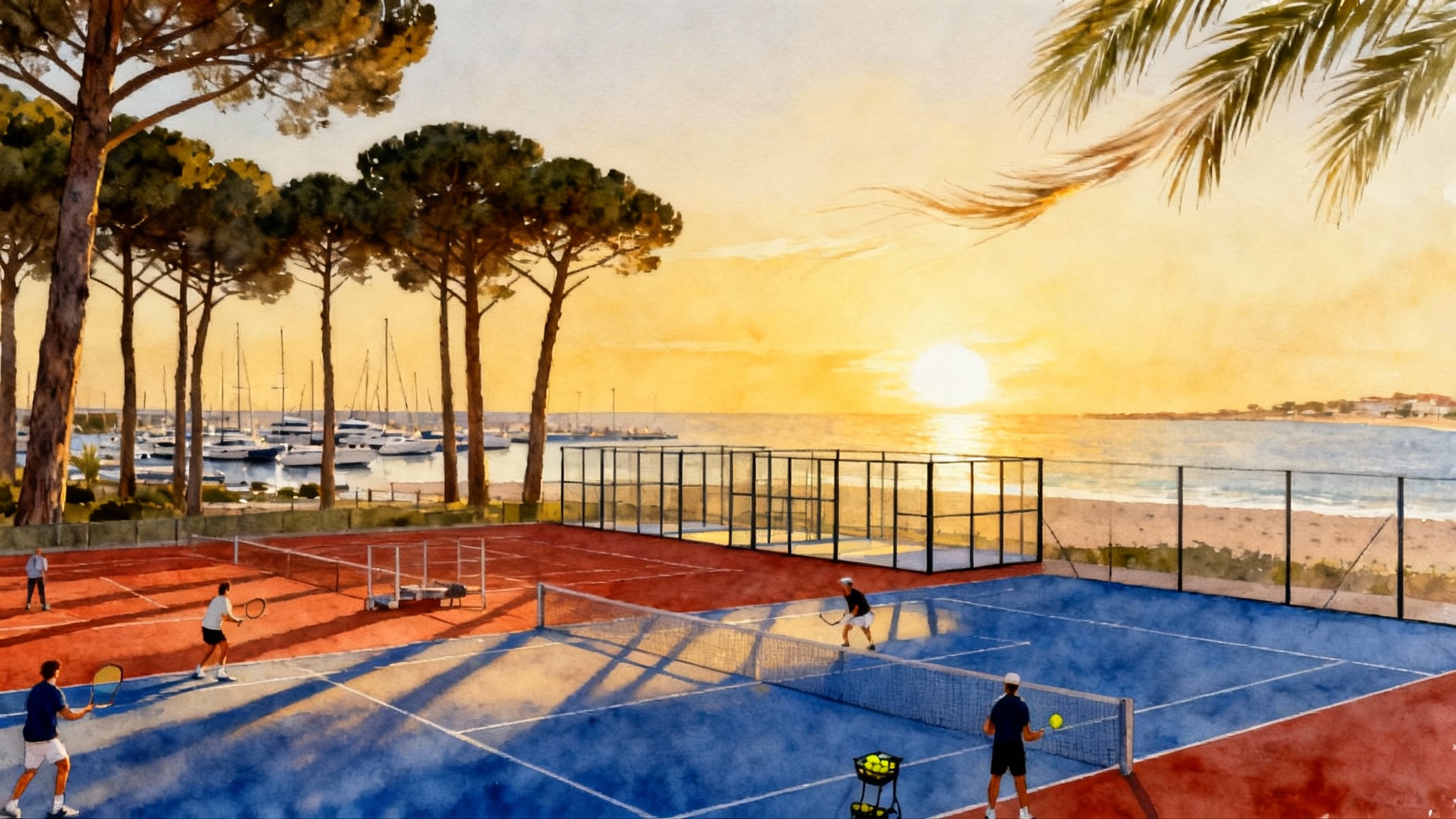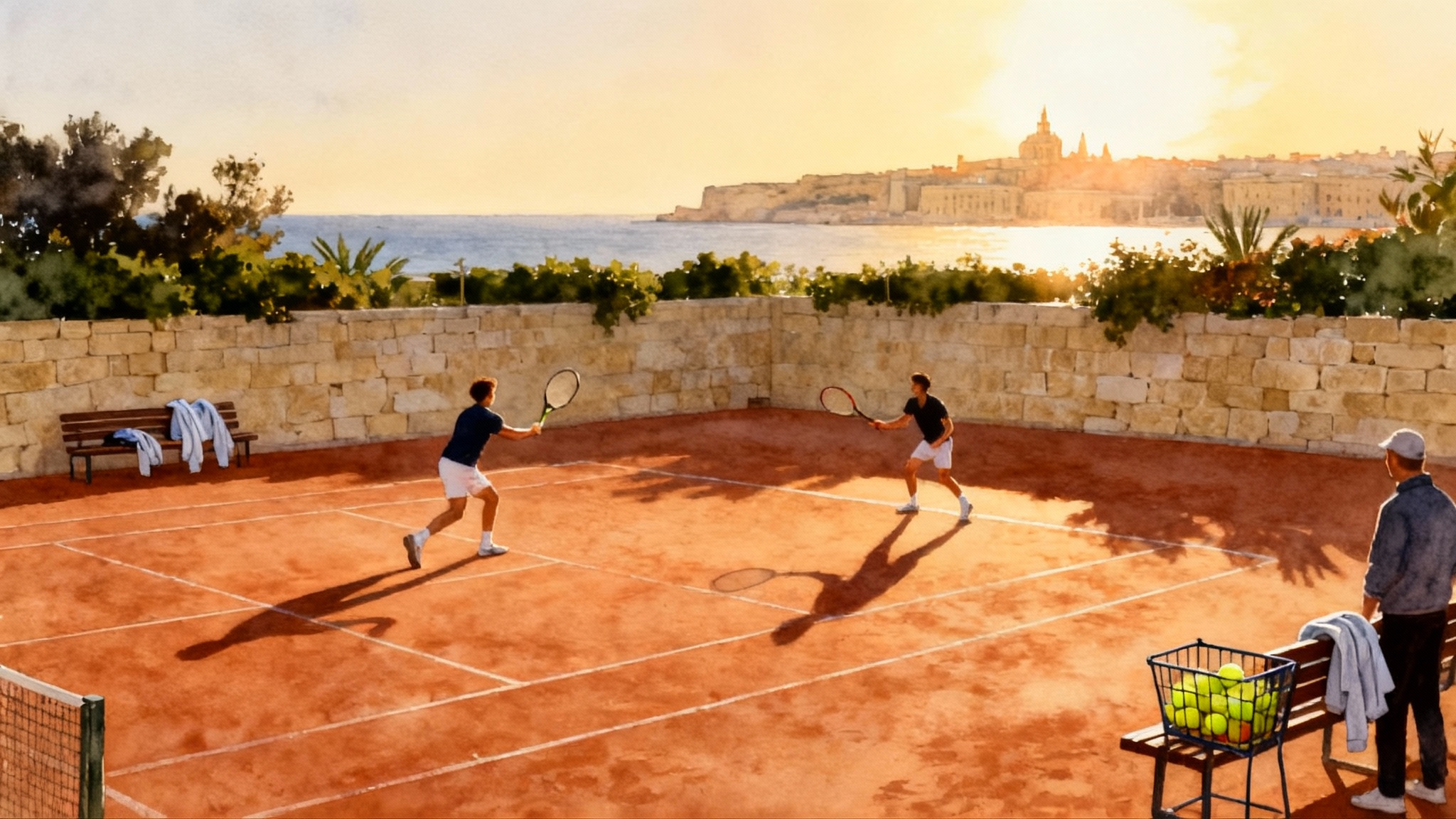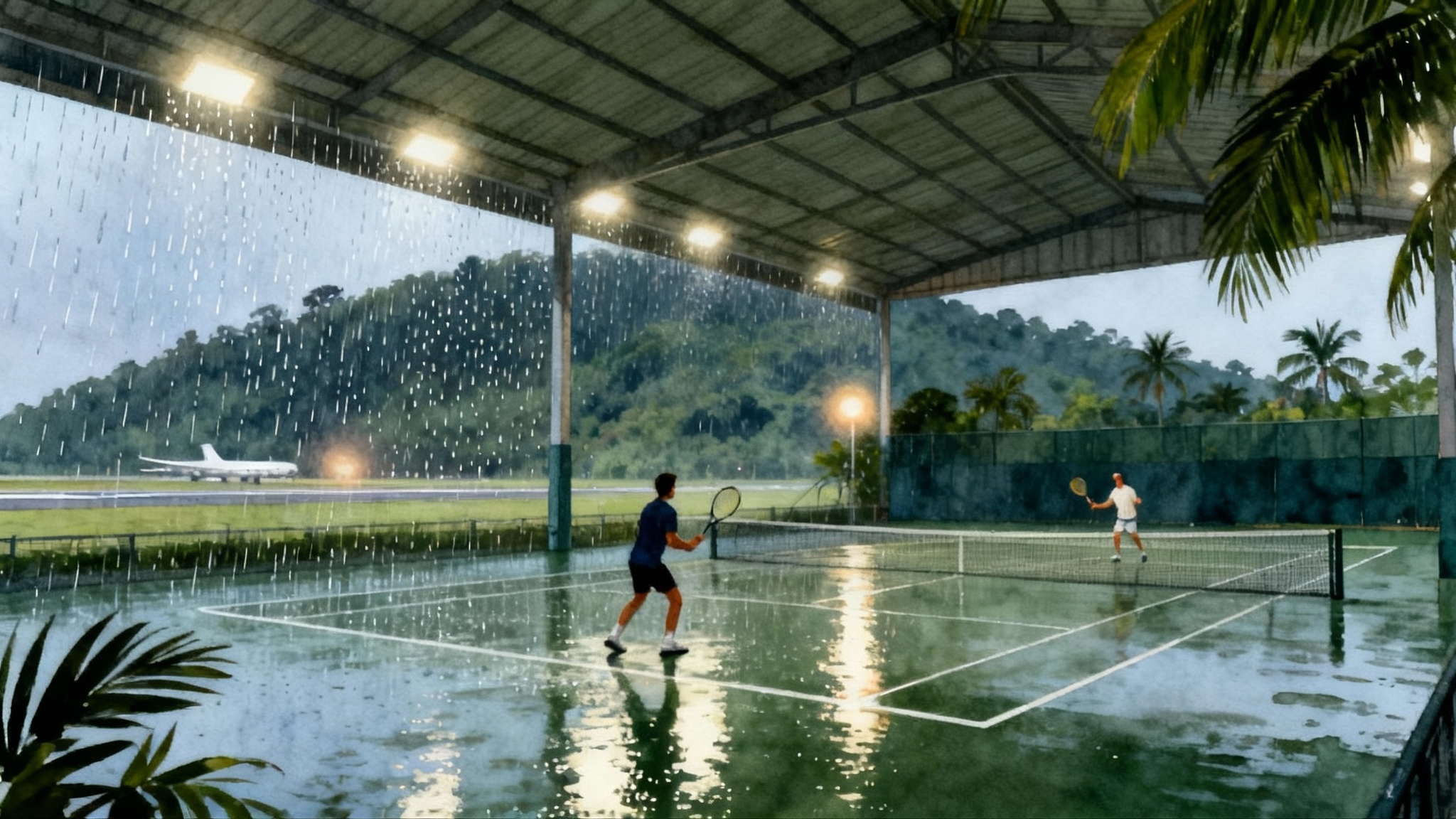Dry Season Tennis 2025-26: Ho Chi Minh City vs Bangkok
Plan a climate-smart tennis block between December and April. Compare Ho Chi Minh City and Bangkok by monthly heat index and rainfall, court types, covered options, best training windows, budgets, visas, flights, and add-on trips.

Why December to April is the sweet spot
If you want a winter training block with real sweat equity, Southeast Asia’s dry season is a reliable window. Between December 1, 2025 and April 30, 2026, both Ho Chi Minh City and Bangkok offer long rain-free stretches, warm mornings, and vibrant city energy after practice. The goal of this guide is simple: help you train more minutes at a quality heart rate while spending fewer minutes hiding from heat or thunderstorms.
Think of the tropics like a dimmer switch rather than an on or off light. Temperature stays warm year-round, but the air’s moisture and cloud cover slide up and down. In dry season the switch sits lower, which means fewer storm interruptions and clearer scheduling. You still need climate-smart timing and shaded courts, but you can plan confidently. For an alternative monsoon playbook elsewhere in the region, see our Bali monsoon-smart tennis guide.
Dry-season climate by month: Ho Chi Minh City vs Bangkok
Below is a practical, not meteorological, way to read the season. Numbers are typical ranges, not guarantees. Heat index uses a shade baseline and assumes light wind.
December
- Ho Chi Minh City: Dry mornings, brief afternoon sprinkles possible. Midday heat index often 90 to 98 Fahrenheit. Evenings feel pleasant with a breeze along the Saigon River.
- Bangkok: Very dry and one of the most comfortable months. Midday heat index around 92 to 99 Fahrenheit. Skies are clear, so sun strength is high.
Training takeaway: Schedule heavy volume in December. Add midday gym work when courts are hottest.
January
- Ho Chi Minh City: The driest feel of the year. Midday heat index 92 to 100 Fahrenheit. Humidity stays moderate, making recovery easier at night.
- Bangkok: Still dry. Midday heat index 94 to 101 Fahrenheit. Air quality can fluctuate; pick green, leafy practice bases when possible.
Training takeaway: Two sessions a day are realistic with smart hydration and shade. Ice towels become your best friend.
February
- Ho Chi Minh City: Starts to warm. Midday heat index 96 to 104 Fahrenheit. Rain still rare.
- Bangkok: Warmer again. Midday heat index 98 to 106 Fahrenheit. Ultraviolet index rises quickly after 9:30 a.m.
Training takeaway: Keep morning sessions long and reduce midday exposure. Move any match play to late afternoon.
March
- Ho Chi Minh City: Hottest stretch. Midday heat index 100 to 108 Fahrenheit. Evenings remain playable with airflow.
- Bangkok: Hottest stretch. Midday heat index 102 to 110 Fahrenheit. Some haze days; pick parks or riverside bases when possible.
Training takeaway: Treat March like altitude camp for heat. Shorter, sharper court blocks plus longer indoor strength or mobility midday.
April
- Ho Chi Minh City: Hot with a few early pre-monsoon showers. Midday heat index 100 to 108 Fahrenheit. Clouds build after 3 p.m.
- Bangkok: Hot with the first convective showers late day. Midday heat index 102 to 112 Fahrenheit.
Training takeaway: Keep a flexible plan. If clouds roll in, slide a bonus late afternoon hit before dinner.
Court surfaces and covered options
-
Ho Chi Minh City: The city skews to hard courts, many with acrylic surfaces similar to North American clubs. District 2, also known as Thao Dien in Thu Duc City, offers a cluster of residential compounds with roofed or semi-roofed hard courts plus open courts with tall shade trees. Local programs such as Saigon Tennis Academy run private and group sessions and can arrange court access during peak hours. Explore the Saigon Tennis Academy program overview before you book.
-
Bangkok: The core districts have mostly outdoor hard courts at private clubs, hotels, and community facilities. Roofed courts exist but are more common at suburban complexes or school facilities. If you must have cover, expand your search east toward Bang Na or north toward Muang Thong Thani. If you want a fully covered destination in Thailand for the hottest weeks, scan our Phuket covered-courts guide.
Practical cue: Roofed does not always mean air-conditioned. A high roof with cross-breeze can feel 5 to 8 degrees Fahrenheit cooler than full sun at noon. Try before you buy for a full week of bookings.
Where to base yourself
Ho Chi Minh City
- District 2, Thao Dien: Expat-friendly, walkable lanes, cafes between sessions, and quick Grab rides to courts. Saigon Tennis Academy and several independent coaches operate here.
- District 7, Phu My Hung: Wide sidewalks, parks, and a quieter vibe. Good for families who want predictable sleep.
Travel time logic: From Thao Dien to central District 1 outside rush hour is 20 to 30 minutes by Grab. During peak traffic, budget 45 minutes. Keep your everyday life compact by staying within 10 minutes of your primary court.
Bangkok
- Sukhumvit corridor, from Phrom Phong to Ekkamai: Apartment hotels, gyms, and plenty of food within a five-minute walk. The Racquet Club in Sukhumvit 49 is a known multi-sport hub, and several private coaches teach across nearby courts.
- Lumphini and Wireless Road: Close to park courts and central clubs. Slightly more business hotels and quieter evenings.
- Ari and Phaya Thai: Leafy neighborhoods with less traffic stress and straightforward transit access.
Transit tip: Bangkok’s BTS Skytrain helps you defeat traffic. Pick a base no more than a ten-minute walk from a station if your court is along the Sukhumvit or Silom lines.
Ideal daily practice windows
Heat moves like a daily wave. Your mission is to surf the shoulders of that wave.
- Morning block: 6:00 to 9:00. Best quality time. Start with a dynamic warmup, then patterning or serve work. If you need two hours on court, start at first light.
- Midday block: 11:30 to 15:30. Use for strength, mobility, video review, and lunch. If you must play, keep it to 45 minutes and chase shade.
- Late afternoon block: 16:30 to 19:00. Match play, live points, serve plus one. The sun angle is kinder and wind picks up.
- Night: 19:30 to 21:00. Reserve for light hitting or hand-fed drills. Good for adults who work remotely in the day.
Hydration rule of thumb: 0.5 to 0.7 liters of fluids per hour of court time plus electrolytes. Use chilled bottles and a small cooler bag. Bring two towels so one can stay on ice between changeovers.
Sample training weeks
Junior performance week, age 14 to 17
- Monday
- 6:30 to 8:30: Footwork ladders, cross-court consistency, serve rhythm
- 12:00: Lunch and nap
- 16:30 to 18:30: Live points, second serve plus first ball
- Tuesday
- 6:30 to 8:30: Patterns against pace, approach and transition
- 14:00: Strength session focused on pulls and unilateral legs
- 18:00: Mobility and breathwork
- Wednesday
- 7:00 to 8:30: Serve targets and returns
- 10:30: School work or online classes
- 17:00 to 19:00: Match play set with coaching on changeovers
- Thursday
- 6:30 to 8:30: Situational games, tiebreaks
- 13:00: Video analysis
- 17:30: Light hit and recovery flush
- Friday
- 6:30 to 8:00: Speed work and reactive drills
- 16:30 to 19:00: Test match, match charting
- Saturday
- 7:00 to 8:30: Topspin forehand heaviness, slice backhand depth
- Afternoon: City walk, museum, or pool
- Sunday
- Morning off
- 17:00 to 18:30: Optional doubles play
Coach-to-athlete ratio: For the highest quality, limit point-play sessions to one coach per two athletes. Keep ball baskets in the shade and rotate serve reps every five minutes.
Adult improver week, 3.0 to 4.0 level
- Monday
- 7:00 to 8:15: Technical tune-up on grip and spacing
- 18:00 to 19:30: Group drills and point starts
- Tuesday
- 6:30 to 7:45: Serve plus first ball targets
- Midday: Gym pull day or Pilates
- Wednesday
- 7:00 to 8:00: Return practice and chip returns
- 18:00 to 19:30: Social doubles
- Thursday
- 6:30 to 7:45: Net play and half-volley control
- 17:00: Mobility and stretching session
- Friday
- 7:00 to 8:15: Patterns for breaking serve
- 18:00 to 19:30: Match play
- Saturday
- 7:30 to 9:00: Hitting session, reduced intensity
- Afternoon: Food tour or spa
- Sunday
- Rest or light 60-minute hit at 18:00
Budget planner: realistic ranges
All numbers are per person unless noted, in United States dollars. Euros track closely at current exchange levels. Prices vary by date and availability, so treat these as planning ranges, not quotes.
- Private coaching: 35 to 70 per hour in Ho Chi Minh City; 40 to 80 in Bangkok. Group sessions: 15 to 30.
- Court fees: 6 to 15 per hour daytime in Ho Chi Minh City; 8 to 20 in Bangkok. Prime-time evenings are higher.
- Balls and water: 6 to 10 per day if you buy new cans and large bottled water.
- Transport: 2 to 6 per intra-city Grab ride. Weekly total 40 to 80 if you base near courts.
- Accommodation per night:
- Ho Chi Minh City District 2 serviced apartment: 45 to 120
- Bangkok Sukhumvit hotel or apartment hotel: 70 to 180
- Food:
- Street and casual meals: 3 to 7
- Mid-range restaurants: 10 to 20
- One-week training total, excluding flights:
- Ho Chi Minh City: 550 to 1,100 for a solo adult mixing five private sessions, four groups, and mid-range lodging
- Bangkok: 650 to 1,250 on a similar schedule and lodging class
- Four-week block, excluding flights:
- Ho Chi Minh City: 1,900 to 3,800 depending on coaching intensity and apartment choice
- Bangkok: 2,200 to 4,400
- Family note: A parent and junior sharing a one-bedroom reduces lodging cost per person by 25 to 40 percent but increases transport a little if you split court times.
Savings tactic: Book a four-week apartment and hold only the first week of coaching. Add later weeks once you confirm court times, heat tolerance, and coach fit.
Visas and flights from the United States and European Union
Rules change. Before you book, review the official pages for your passport country and the destination. Vietnam operates an official electronic visa portal with current categories and fees. Start with the Vietnam government e-visa site. This is a high-stakes step, so do not rely on third-party blogs.
Thailand updates visa exemptions and electronic visa options through the Ministry of Foreign Affairs and the Royal Thai Police Immigration Bureau. Check the official Thailand visa policy for current lengths of stay and eligible nationalities before you fly.
Flight planning
- From the United States West Coast: One-stop itineraries to both cities run 18 to 22 hours total travel time. Common connections are Taipei with EVA Air, Tokyo with Japan Airlines, or Seoul with Korean Air.
- From the United States East Coast: Two-stop options are common; one-stop via Doha on Qatar Airways or via Tokyo can work but adds distance.
- From the European Union: One-stop itineraries via the Gulf carriers or via Singapore Airlines are efficient. Flight times often sit between 14 and 17 hours of air time plus your connection.
- Price ranges: December holidays are peak. If you want value, fly the first two weeks of December or late January. Use fare alerts and set a walk-away price before you start searching.
Seat comfort tip: For long-haul economy, prioritize airlines with 2-4-2 seating on the Airbus A330 or 3-3-3 on the Boeing 787 when possible. Your hips will notice.
Add-on travel to make it tennis plus
From Ho Chi Minh City
- Mekong Delta day or overnight: Slow boats, coconut workshops, and relaxed pacing for a true rest day.
- Cu Chi Tunnels: Combine light morning hit with a half-day history trip.
- Vung Tau or Ho Tram: Beach weekend within a few hours’ drive for recovery walks.
- Da Lat or Da Nang by short flight: Cooler air as a reward after a hard training block.
From Bangkok
- Ayutthaya: Riverfront ruins and a gentle cycling loop. Perfect for a no-impact day.
- Kanchanaburi: Waterfalls and World War II history. Go early to avoid heat.
- Koh Samet: Short ferry away with calm beaches and easy logistics.
- Chiang Mai: A quick domestic flight for mountain air and cafes.
Recovery mindset: Let the travel day be your active recovery. Walk, stretch, and hydrate. Save the sprinting for the first session back.
Quick decision rules
- You want a compact bubble with short rides between home, courts, and food: Choose District 2 in Ho Chi Minh City.
- You want heavy morning training plus excellent transit for city exploring: Choose central Bangkok near the BTS.
- You need covered courts at midday: Ho Chi Minh City has more roofed options in the main training neighborhoods. Bangkok has cover, but you may travel farther.
- You plan to add beach days without another international flight: Bangkok pairs easily with Koh Samet or Hua Hin by road; Ho Chi Minh City pairs with Vung Tau or Ho Tram.
- You are bringing a junior who needs consistent sleep: Both cities work, but District 7 in Ho Chi Minh City is the quietest of the popular bases.
Putting it together: two sample bases
-
Ho Chi Minh City, District 2 base
- Stay: Serviced apartment along Nguyen Van Huong
- Train: Morning at a roofed compound court, afternoon match play at a nearby open court
- Live: Walk to cafes and a small supermarket between sessions
- Weekend: Day trip to Mekong Delta
-
Bangkok, Sukhumvit base
- Stay: Apartment hotel near Phrom Phong BTS
- Train: Morning drills at a central club, late afternoon match play under lights
- Live: Lunch in air-conditioned malls, recover in the pool or with a massage
- Weekend: Day trip to Ayutthaya
Final serve
If your priority is shade, short commutes, and a neighborhood feel, Ho Chi Minh City’s District 2 makes a terrific winter home base. If you prefer transit convenience, big-city variety after practice, and a dense grid of central clubs, Bangkok is hard to beat. Both reward early alarms and smart hydration. Pick one, lock in your ideal court window, and treat the next four months as a simple cycle: hit, recover, explore, repeat. Your spring results will thank you.
